Violet YAN-Caprice: description and rules of care
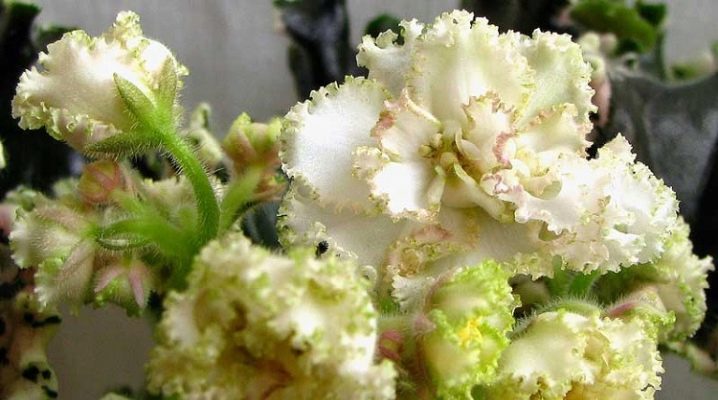
Having taken up the cultivation of violets of the YAN-Kapriz variety, many novice growers remain disappointed, since the culture does not bloom for the first years. However, do not be upset, this is the peculiarity of the variety - beautiful lush flowers sometimes appear only in the third or even fourth year of the plant's life. In order not to wait so long, it is important to provide the flower with suitable conditions for its proper development.

Description
First of all, it should be noted that the YAN-Caprice variety has nothing to do with the usual room violet, it belongs to the genus Saintpaulia. Sometimes in floriculture this genus of herbaceous plants is referred to as "Uzambara violet", therefore some flower lovers call "YAN-Caprice" violet for convenience and simplicity of the syllable. This is what we will call this variety in our article.
"YAN-Kapriz" is a plant of an interesting shape and unusual color. The flowers have milky white wavy petals, framed by a greenish or bronze color. The leaves of the flower also have a wavy shape, along the edge of the leaf there is a white or pinkish border. The leaf itself is shiny, and its edge has a velvety texture. The older the plant, the wider the leaf frame becomes.

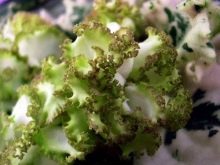
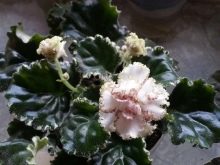
Varieties of varieties may differ in the shape and color of the leaves. For example, the foliage can be very curly, and the flower inside has a brown tint. Another species may have slightly wavy leaves, and its flowers will differ in a green frame.
The variety has a medium rosette up to 25 cm in diameter. It is characterized by very slow growth. The minimum time to bloom is 1.5 years. The very first blooms are white; with age, the flowers are filled with more and more juicy color. The flowering period itself is quite long, one flower can last up to 6 weeks. Each flowering is characterized by the appearance of 1-2 peduncles, each of which has 4-5 flowers. Dissolving, the buds do not fall over, since the peduncles are quite stable.

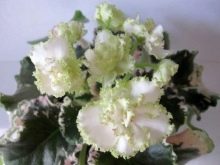

Care
In order for Saintpaulia to please the owner with abundant and lush flowering, it is necessary to create suitable conditions.

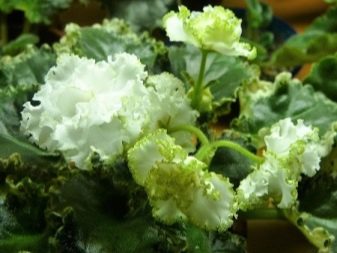
It is not for nothing that the culture received just such a name, it is indeed somewhat capricious and picky about the conditions of life, it is not so easy to achieve good flowering.
- The plant loves light, so it is important to provide it with good lighting. However, do not expose the leaves to direct ultraviolet rays, as this can cause burns. Daylight hours for violets should last at least 10 hours. During the flowering period, experienced florists recommend supplementing the lighting with a fluorescent lamp.
- In the summer months, the air temperature should not exceed +25 degrees, in winter the thermometer should be at a maximum of +20 degrees. If the temperature values are exceeded, then the owner of the plant will not be able to witness a bright flowering. Flowers grown in too warm conditions have small buds, a faded color, and a dull border.
- YAN-Kapriz loves light, loose soil. It is best to buy a generic mix from the store. If the composition is prepared independently, then the soil must be calcined in the oven in order to eliminate all invisible larvae. The most favorable mixture for violets contains peat, dried moss, sand, leafy soil, and coal.
- Choose small containers for planting. In a spacious pot, the variety will not bloom for a long time, since the first flowers appear only when the roots occupy the entire space of the soil.For an adult plant, a container with a diameter of 10-12 cm is suitable, for a young shoot - 5-6 cm. When choosing a pot, there is a win-win advice: choose a container whose diameter is 3 times smaller than the flower outlet.
- Watering "YAN-Kapriz" needs 1-2 times in 7 days. Bottom watering is recommended. To do this, the pot is lowered ¼ into a bowl of water for 20 minutes, then removed, water is poured out of the pan. After the excess moisture has drained off, the pot is put in place.
- Humidity is of great importance for growing crops. This indicator should be at the level of 50%. It is impossible to spray the YAN-Caprice variety, as the downy leaves on the leaves retain moisture, which can lead to decay. To maintain humidity, it is recommended to place a container with water next to the flowerpot. Every month the flower needs shower procedures, after which the entire specimen is dried, moisture is gently removed with a sponge.
- It is important to exercise caution when fertilizing the plant. "YAN-Caprice" itself is notable for its slow growth, and if you overfeed it, you can wait for flowering for many years. The frequency of feeding should not exceed twice a month. During active growth of foliage, nitrogen-containing mixtures are needed. Potassium-phosphorus products are suitable for abundant flowering. Experienced flower growers recommend using the complexes "Etisso", "Bona Forte", "Master" for Saintpaulia.
- The process of plant transplantation also deserves attention. Every year, the violet needs to be updated in the soil. Before transplanting, it is important to carefully examine the roots, remove rotten parts, and leave only healthy, strong specimens. Places of cuts should be treated with crushed activated carbon. If the rot has completely affected the root system, then all roots should be cut to living tissue, and then the flower should be placed in sphagnum moss to develop new roots.
The violet needs to be transplanted in the spring, but if the plant is affected by pests or diseases, then you should not wait for the spring months.

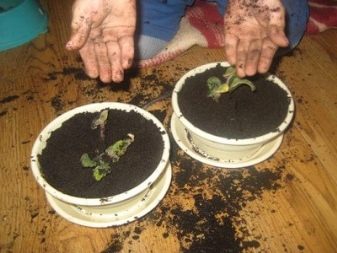
Diseases and pests
Separately, it should be said about diseases and insects that can attack this culture. The most common cause of the appearance of parasites is improper growing conditions.
In case of florist's mistakes, the plant loses its immunity and is easily attacked by pests.

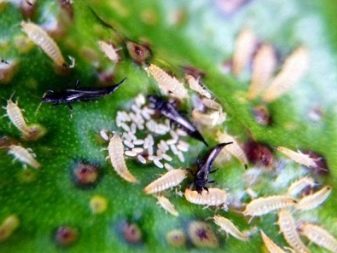
The most common ailments of YAN-Kapriz Saintpaulia are fungi. These include powdery mildew, fusarium, gray rot, late blight, rust. Spraying leaves and low air temperature in the room leads to diseases. You can distinguish the fungus by the dark and brown spots on the leaf plate, and spores and white bloom are also formed on the leaf.
Fungicides will help to cope with the disease.
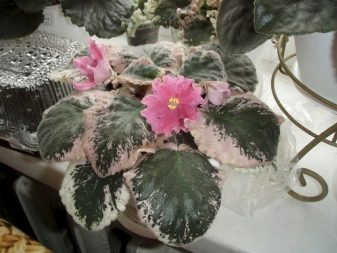
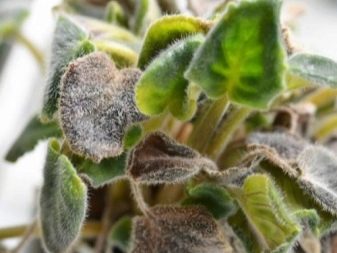
You can often see how the leaves of the violet become yellow and start to fade. These signs indicate overheating or direct exposure to the leaves of the sun's rays. In this case, it is recommended to place the flower in a cooler and shaded place, and in the future arrange diffused lighting for the plant. The formation of root rot can also be the cause of the unhealthy appearance of the leaves. This disease appears if the culture is transfused. Another sign of decay is the occurrence of mold.
Trimming rotten roots and transplanting into new soil will help to cope with the disease.
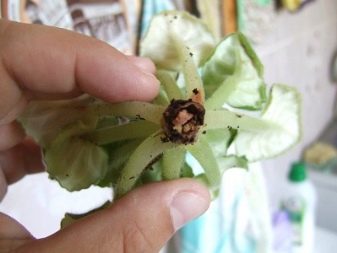

Of the insects, ticks, thrips, aphids, nematodes, scale insects, whiteflies like to feast on saintpaulia most of all. Often these insects are visually noticeable; under their negative influence, spots, dots, cobwebs are formed on the leaves. To prevent the appearance of pests, it is important to observe the temperature regime, reduce the frequency of watering when the temperature drops, and systematically ventilate the room. For the fight against insects, the means "Aktellik", "Intavir", "Fitoverm" will be effective. For processing, the preparations are diluted in water in the proportions indicated on the package.
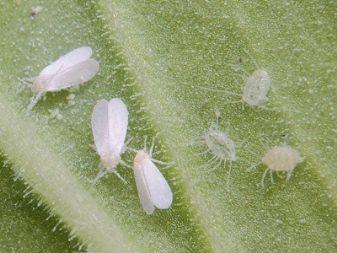
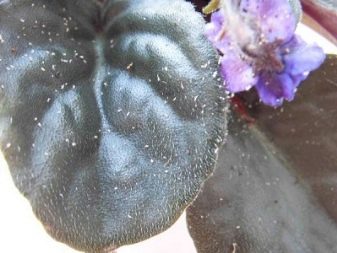
You can find out about the features of the variety and the conditions for keeping violets YAN-Caprice by watching the video below.































The comment was sent successfully.